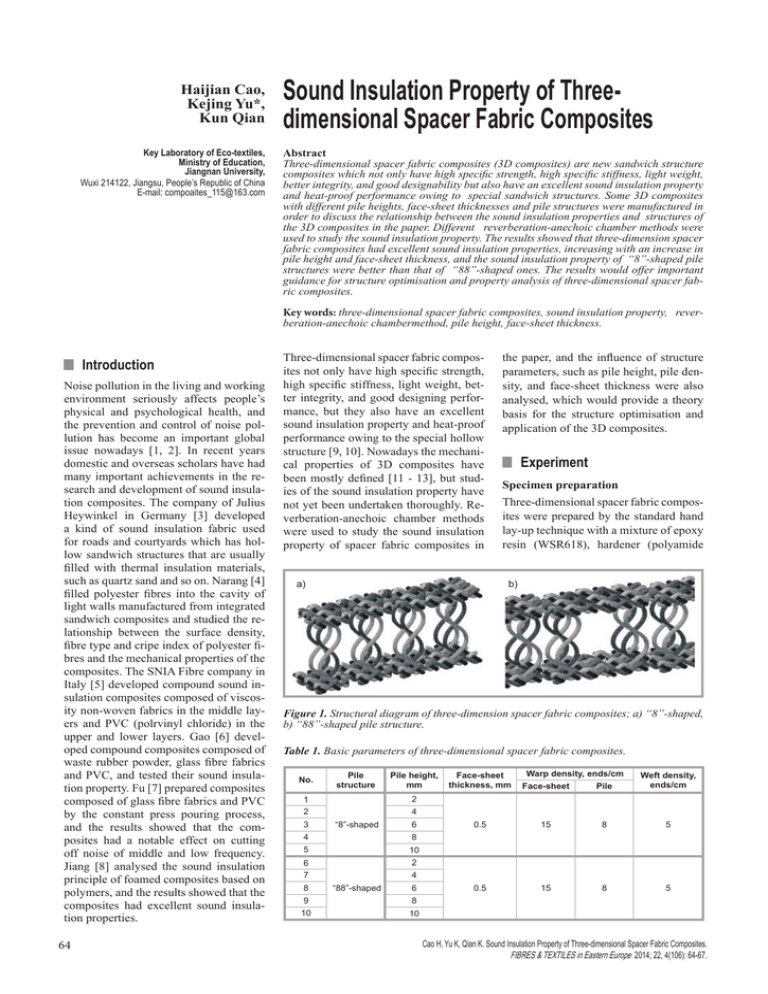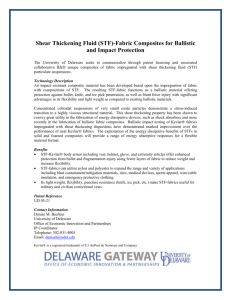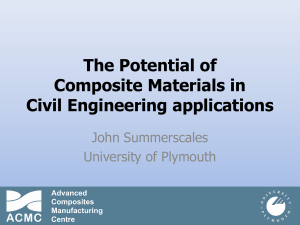Sound Insulation Property of Three- dimensional Spacer Fabric Composites Haijian Cao, Kejing Yu*,
advertisement

Haijian Cao, Kejing Yu*, Kun Qian Key Laboratory of Eco-textiles, Ministry of Education, Jiangnan University, Wuxi 214122, Jiangsu, People’s Republic of China E-mail: compoaites_115@163.com Sound Insulation Property of Threedimensional Spacer Fabric Composites Abstract Three-dimensional spacer fabric composites (3D composites) are new sandwich structure composites which not only have high specific strength, high specific stiffness, light weight, better integrity, and good designability but also have an excellent sound insulation property and heat-proof performance owing to special sandwich structures. Some 3D composites with different pile heights, face-sheet thicknesses and pile structures were manufactured in order to discuss the relationship between the sound insulation properties and structures of the 3D composites in the paper. Different reverberation-anechoic chamber methods were used to study the sound insulation property. The results showed that three-dimension spacer fabric composites had excellent sound insulation properties, increasing with an increase in pile height and face-sheet thickness, and the sound insulation property of “8”-shaped pile structures were better than that of “88”-shaped ones. The results would offer important guidance for structure optimisation and property analysis of three-dimensional spacer fabric composites. Key words: three-dimensional spacer fabric composites, sound insulation property, reverberation-anechoic chambermethod, pile height, face-sheet thickness. nIntroduction Noise pollution in the living and working environment seriously affects people’s physical and psychological health, and the prevention and control of noise pollution has become an important global issue nowadays [1, 2]. In recent years domestic and overseas scholars have had many important achievements in the research and development of sound insulation composites. The company of Julius Heywinkel in Germany [3] developed a kind of sound insulation fabric used for roads and courtyards which has hollow sandwich structures that are usually filled with thermal insulation materials, such as quartz sand and so on. Narang [4] filled polyester fibres into the cavity of light walls manufactured from integrated sandwich composites and studied the relationship between the surface density, fibre type and cripe index of polyester fibres and the mechanical properties of the composites. The SNIA Fibre company in Italy [5] developed compound sound insulation composites composed of viscosity non-woven fabrics in the middle layers and PVC (polrvinyl chloride) in the upper and lower layers. Gao [6] developed compound composites composed of waste rubber powder, glass fibre fabrics and PVC, and tested their sound insulation property. Fu [7] prepared composites composed of glass fibre fabrics and PVC by the constant press pouring process, and the results showed that the composites had a notable effect on cutting off noise of middle and low frequency. Jiang [8] analysed the sound insulation principle of foamed composites based on polymers, and the results showed that the composites had excellent sound insulation properties. 64 Three-dimensional spacer fabric composites not only have high specific strength, high specific stiffness, light weight, better integrity, and good designing performance, but they also have an excellent sound insulation property and heat-proof performance owing to the special hollow structure [9, 10]. Nowadays the mechanical properties of 3D composites have been mostly defined [11 - 13], but studies of the sound insulation property have not yet been undertaken thoroughly. Reverberation-anechoic chamber methods were used to study the sound insulation property of spacer fabric composites in a) the paper, and the influence of structure parameters, such as pile height, pile density, and face-sheet thickness were also analysed, which would provide a theory basis for the structure optimisation and application of the 3D composites. nExperiment Specimen preparation Three-dimensional spacer fabric composites were prepared by the standard hand lay-up technique with a mixture of epoxy resin (WSR618), hardener (polyamide b) Figure 1. Structural diagram of three-dimension spacer fabric composites; a) “8”-shaped, b) “88”-shaped pile structure. Table 1. Basic parameters of three-dimensional spacer fabric composites. No. Pile structure Pile Weft density, ends/cm 6 0.5 15 8 5 0.5 15 8 5 8 10 2 6 7 9 10 Face-sheet 4 “8”-shaped 4 5 8 Warp density, ends/cm Face-sheet thickness, mm 2 1 2 3 Pile height, mm 4 “88”-shaped 6 8 10 Cao H, Yu K, Qian K. Sound Insulation Property of Three-dimensional Spacer Fabric Composites. FIBRES & TEXTILES in Eastern Europe 2014; 22, 4(106): 64-67. 651), and diluents (propylene oxide tertbutyl ether 660). The mass ratio of the mixture is 100 of epoxy resin, 20 of hardener, and 10 of diluents [13]. Two types of structural diagram of the 3D composites are shown in Figure 1 “8”-shaped pile structure and “88”-shaped pile structure. Computer Data acquisition unit Reverberation room Basic parameters of the three-dimensional spacer fabric composites are shown in Table 1. The sound transmission loss was used to characterise the sound insulation property of the three-dimension spacer fabric composites in the test, which namely equals the subtraction of the power level of the incidence sound from that of the transmission sound, also known as the sound transmission loss (STL). Referencing ISOR140-1 and ISORl40-170, measurement standards of sound insulation used in building and construction components, an A-weighting network of 80 dB sound pressure level (SPL) and with a pink background noise source was selected. The size of the static voice box was 1000 mm length, 1000 mm width and 1000 mm height, the sound sampling frequency 48,000, and the sample number of fast fourier transform (FFT) was 4096. The size of test samples was 250 mm length and 250 mm width. Figure 2. Reverberation-anechoic chambers measuring system. For the same sound insulation composites, different frequencies have different sound insulation. Therefore one third octave of testing was used and 16 center frequencies chosen, including 100, 125, 160, 200, 250, 315, 400, 500, 630, 800, 1000, 1250, 1600, 2000, 2500 and 3150 Hz. At the same time, curves of sound insulation of the 3D composites were made which can reflect the sound insulation property comprehensively. However, it is complex and not ocular to express the sound insulation property owing to a great value of the test. To put it simply, the arithmetic mean value of sound insulation at each frenquency band, namely the average sound transmission loss (STL), was used to evaluate the ability of sound insulation of the composites in the paper. The aver- 1 N TL = ∑ T L i (1) TL N i =1 TLi L is the average value of sound Where, T TLi loss (dB), TLi the sound transmission transmission loss of one third octave (dB), Ni the number of measuring sound insulation frequency bands, and i equals 1 to 16. n Results and discussion Influence of pile height on the sound insulation property Curves of the relationship between frequency and transmission loss in the condition of different pile heights are shown in Figure 3. It can be seen that the com- 2 mm 4 mm 6 mm 8 mm 10 mm 25 Transmission loss, dB 20 age value [17] of sound insulation can be calculated as formula (1). 30 2 mm 4 mm 6 mm 8 mm 10 mm 25 Transmission loss, dB Silence box Sample 30 15 10 20 15 10 5 5 0 Sound source Power amplifier Sound insulation property test Testing of sound insulation properties of the three-dimension spacer fabric composites was done by the reverberationanechoic chamber method [14, 15] in this paper. The test system used was a BSWA VS302USB double track acoustic analyser, as shown in Figure 2. Microphone 1 Microphone 2 0 400 800 1200 1600 2000 Frequency, Hz 2400 2800 3200 0 0 400 800 1200 1600 2000 Frequency, Hz 2400 2800 3200 Figure 3. Relationship between frequency and transmission loss in the condition of different pile height; a) “8”-shaped, b) “88”-shaped pile structure. FIBRES & TEXTILES in Eastern Europe 2014, Vol. 22, 4(106) 65 15 10 5 0 30 20 10 0 2 4 6 Pile height, mm 8 10 Figure 4. Influence of pile height on sound insulation property of 3D spacer fabric composites. posites have certain sound insulation properties at different frequencies and the difference is great. The sound insulation effects are worst when the frequency is under 800 Hz, and the sound insulation effects are best when it is between 800 and 1600 Hz. The sound insulation properties are better and sound transmission loss has small fluctuation when the frequency is over 1600 Hz. What is more the sound insulation properties vary greatly with an increase in pile height. The relationship between the pile height and sound insulation properties of the composites is shown in Figure 4. 1) The sound insulation properties of the three-dimensional spacer fabric composites increased gradually with an increase in the pile height. When the pile height was increased from 2 to 10 mm, the average value of sound transmission loss of “8”-shaped spacer fabric composites increased from 12 to 18 dB, while that of “88”-shaped ones increased from 10 to 16 dB, the reason for which being variation in the thickness of the air layer resulting in a change in the sound insulation proper- „8”-shaped pile structure „88”-shaped pile structure 40 Average transmission loss, dB Average transmission loss, dB „8”-shaped pile structure „88”-shaped pile structure No additional fabrics One-layer fabrics Status of facesheet Two-layer fabrics Figure 6. Influence of pile height on sound insulation property of 3D spacer fabric composites. ties [16]. Elastic deformation of the air layer provides a vibration damping for the acoustic wave. The air layer thickness between the upper and lower face-sheet increased and the vibration that passed to the down face-sheet decreased greatly with an increase in the pile height of the composites, which increased the total sound transmission loss of the three-dimensional spacer fabric composites. 2) The average value of sound transmission loss of the “8”-shaped structure was higher than that of the “88”-shaped one in the three-dimensional spacer fabric composites, which indicated that the sound insulation properties of “8”-shaped structures was better than that of “88”-shaped ones. The reason is that when the sound waves reached the hollow parts of the composites, the times and paths of reflection, scattering, refraction and diffraction of the sound wave happening in them were different owing to the varied arrangement of the law of the piles, which resulted in a different depletion degree of the sound wave. At the same time, the fabric density of the “8”-shaped structures was higher than that of the “88”-shaped ones, which also resulted in different sound insulation properties of the two types of spacer fabric composites. 3) The average value of sound transmission loss increased obviously when the pile height of the three-dimension spacer fabric composites was increased from 8 to 10 mm, which can be explained by the fact that the sound insulation effects of the 3D composites enhanced significantly when the pile height of the composites was increased to a certain degree. The reason for this can be that the composites with the a pile height of 10 mm increased not only the value of sound transmission loss, ranging between 800 and 1600 Hz, but also that of sound transmission loss under 800 Hz. Influence of face-sheet thickness on the sound insulation property The three-dimensional spacer fabric composites of “8”-shaped and “88”-shaped structure with a pile height of 6 mm were Table 2. Structural parameters of 3D spacer fabric composites. 66 Pile height, mm Face-sheet thickness, mm No. Pile structure 1 “8”-shaped (face-sheet covered with no additional fabric) 2 “8”-shaped (face-sheet covered with one-layer of fabric) 3 “8”-shaped (face-sheet covered with two-layers of fabrics) 1.5 4 “88”-shaped (face-sheet covered with no additional fabric) 0.5 5 “88”-shaped (face-sheet covered with one-layer of fabric) 6 “88”-shaped (face-sheet covered with two-layers of fabrics) Warp density, ends/cm Face-sheet Pile Weft density, ends/cm 15 8 5 15 8 5 0.5 6 6 1.0 1.0 1.5 FIBRES & TEXTILES in Eastern Europe 2014, Vol. 22, 4(106) 30 facesheet covered with one-layer fabric facesheet covered with two-layer fabric 20 15 10 5 0 400 800 1200 1600 2000 Frequency, Hz 2400 2800 facesheet covered with no additional fabric facesheet covered with one-layer fabric facesheet covered with two-layer fabric 25 Transmission loss, dB 25 Transmission loss, dB 30 facesheet covered with no additional fabric 3200 20 15 10 5 0 400 800 1200 1600 2000 Frequency, Hz 2400 2800 3200 Figure 5. Relationship between frequency and transmission loss in the condition of different face-sheet status; a) “8”-shaped, b) “88”-shaped pile structure. chosen to study the influence of face-sheet thickness on the sound insulation properties, as shown in Table 2 (see page 65). Curves of the relationship between frequency and transmission loss in the condition of different face-sheet statuses are shown in Figure 5. It can be seen that the composites have certain sound insulation properties at different frequencies and the difference is great, as expressed in Figure 3. What is more, the sound insulation properties vary slightly with a change in the face-sheet status. The relationship between the face-sheet thickness and average value of sound transmission loss is shown in Figure 6. 1) The average transmission loss clearly increased when the three-dimensional spacer fabric composites were covered with a layer of fabric skins, and the sound insulation properties of the composites covered with two layer fabric skins were better than of those with one layer. According to the law of mass action [17], the quality of the composites per unit area and the propagation path and energy consumption of the sound wave in the composites would both increase with an increase in the face-sheet thickness. Therefore an increases in face-sheet thickness could enhance the sound insulation properties of the three-dimensional spacer fabric composites significantly. 2) The sound insulation properties of “8”-shaped structures would increase faster than that of “88”-shaped ones when the three-dimensional spacer fabric composites are covered with a layer of fabric skins. The reason for this can be that on the one hand the FIBRES & TEXTILES in Eastern Europe 2014, Vol. 22, 4(106) density of „8”-shaped structures is higher than that of „88”-shaped ones. According to the law of mass action [18], the sound insulation properties of „8”-shaped structures are better than those of „88”-shaped ones. But on the other hand the combined actions of the face-sheet thickness and pile density lead to an increased range of the sound insulation properties of „8”-shaped pile structures faster than for „8”-shaped ones. nConclusion References 1. Thiruchelvam M, Kumar S, Visvanathan C. Energy Policy 2003; 31, 10. 2. Liu TT, Liu YL. Journal of Bingtuan Education Institute 2005; 15, 6. 3. China Textile News 2003: 10-16. h t t p : / / w w w. t e x i n d e x . c o m . c n / A r t i cle/2003-10-16/19132.html 4. Narang PP. Appl. Acoustics 1995; 45, 4. 5.Muzi. China Textile News 2003; 9-23. 6. Gao L, Yao YF, Luo YB. Journal of Zhengjiang Institute of Science and Technology 2008; 25, 5. Three-dimensional spacer fabric composites are new sandwich structure composites, which not only have high specific strength and stiffness, light weight, better integrity, and good designability, but also have an excellent sound insulation property and heat-proof performance owing to special sandwich structures. The work revealed the relationship between the sound insulation properties and structures of the 3D composites. The results showed that three-dimensional spacer fabric composites have excellent sound insulation properties, especially for a sound wave range between 800 and 1600 Hz. The sound insulation property increased with an increase in pile height and face-sheet thickness, and the sound insulation property of “8”-shaped pile structures were better than that of “88”-shaped ones. The results represent an important guidance function for structure optimisation and property analysis of the 3D composites. 7. Fu YQ, Ni QQ, Yao YF. Acta Materiae Acknowledgements 18. Antnio J, Godinho L, Tadeu A. Journal of Compositae Sinica 2005; 22, 5. 8. Jiang XH, Li FH. Synthetic Materials Aging and Application 2002; 31, 3. 9. Kuang N, Zhou GM, Zhang LQ. Fiber Glass 2007; 5. 10.Corigliano A, Rizzi E. Composites Science and Technology 2000; 60, 11. 11.Van Vuure AW, Ivens JA, Verpoest I. Composites Part A 2000; 31, 7. 12.Hosur MV, Abdullah M, Jeelani S. Composite Structures 2005; 69, 2. 13. Cao HJ, Qian K, Wei QF. Journal of Textile Research 2009; 30, 10. 14.Fu YQ, Zhu CY, Yu LM. Acta Materiae Compositae Sinica 2008; 25, 2. 15.Pan ZL, Jin JS, Huang YX. Journal of Zhejiang University: Sciences Edition 1993; 20, 1. 16.Zhang SY. Xi’an University of Archi- tecture Technology, 2009. 17.Tadeu A, António J, Mateus D. Applied Acoustics 2004; 65, 1. The work was supported by the Program for Fundamental Research Funds for the Central Universities (JUSRP11101 & JUSRP21106). Sound and Vibration 2004; 273, 3. Received 07.05.2012 Reviewed 04.02.2014 67





